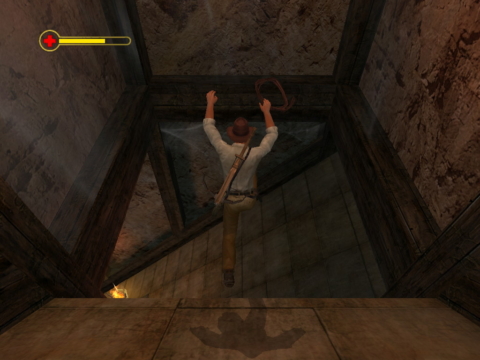
Indiana Jones and the Emperor’s Tomb
Written by: Rik
Date posted: February 21, 2022
- Genre: Action
- Developed by: The Collective
- Published by: LucasArts
- Year released: 2003
- Our score: 7
Despite the success of LucasArts’ point and click adventures bearing Dr. Jones’ name, they both struggled to a certain extent with the more dynamic knockabout action elements that fans were used to seeing from the movies. Indeed, fisticuffs were considered such an essential part of the experience to demand inclusion in both The Last Crusade and Fate of Atlantis, and while these sequences were apparently less problematic in the latter than the former, they were always going to be a challenge to pull off successfully within the confines of the genre.
And, while your correspondent attempted at some point in the distant past to make an argument that the 3D follow-up, Indiana Jones and the Infernal Machine, delivered that combination of action and adventure much more successfully, looking back, that was possibly an overly generous assessment of what was, to all intents and purposes, a game very much in the mould of other established contemporary titles that also involved moving blocks, pulling levers and attempting unlikely jumps.
The Emperor’s Tomb is a more rounded affair, balancing the leaps and puzzles of the previous game with more story interludes and periods of sustained action. And fist-fighting has received particular attention, with developers The Collective able to draw upon their previous expertise in delivering third-person beat ’em up action through their well-received Buffy The Vampire Slayer tie-in on Xbox and put it to good use here.
It’s definitely a slow starter, with nothing by way of introduction, and the opening levels in Ceylon are too long and too tricky to serve merely as prologue or tutorial. It’s a bit of a solo trudge through a dungeon, with some fairly fiddly sections that can be easy to fail and necessitate an occasionally long-winded repeat, given the use of a checkpoint saving system rather than a manual mid-level save.
You’re also introduced to some gameplay elements in a way that suggests they’re going to be much bigger parts of the later game than they actually are, which turns out to be a relief as they’re pretty annoying in the first place. For example, the need to distract some enemies by throwing a blunt object in their general direction suggests the upcoming presence of clumsy stealth sections, but with the exception of one fairly terrible bit in a Nazi base (that you can fight/fluke your way through) that opening is as tough as it gets in that regard.
On the more positive side, the controls are fairly easy to get to grips with, and have been streamlined from the previous game, presumably to allow easy mapping to a dual-stick controller, although the second stick doesn’t seem to be recognised in this PC version, while all the prompts make reference to keyboard and mouse controls, which work fine anyway. The game is also a lot more helpful than The Infernal Machine when it comes to telling you what you might need to do where, with little icons appearing at the top of the screen when you need to deploy your trusty whip to swing across somewhere or cut through something with a machete.
His trip to Ceylon complete, Indy returns to New York for the traditional sequence in which his work at the university is interrupted by strangers requesting that he go off in search of a mysterious artefact with incredible mystical powers before it falls into the wrong hands. As usual, said hands include those of the Nazis, who return as antagonists after Infernal Machine‘s flirtation with post-war Soviet Russia, with the action here taking place prior to the events of the films, in 1935.
Locations hit many of the same notes as the films, from European castles and Nazi submarine bases to the streets of Hong Kong, the last of which actively references the opening of Temple of Doom and include an appearance from Wu Han, the character played by David Yip in the movie. Indeed, there is even a Hong Kong chase sequence, one of several on-rails machine gun shooting sections peppered throughout for an occasional change of pace. While not particularly diverting in themselves (and I was mildly disappointed that a cable-car segment with potential for shooting a hole in your own method of transportation passed up the opportunity to make reference to Sean Connery’s biplane faux pas in Last Crusade), in small doses they work well to up the action quotient in amongst all the leaping and puzzle solving.
The other element that helps in this regard is the aforementioned fist-fighting, which nicely replicates the pantomime physicality of the movies, with bottles and table legs being smashed over heads, combatants being kicked in the stomach while prone, and weapons changing hands mid-battle as they fall loose on the floor. There are some nice touches, from sneaking up behind someone and smacking them out of a window or off a ledge, whereupon they may fall to their doom, or make a miraculous grab for the edge on the way down and pull themselves back up. While guns do feature, their power has been scaled down in order to make fists a more feasible option, leaving you with the occasionally comical sight, in this context, of enemies getting up off the ground having been pumped full of machine gun rounds at close range.
It’s not perfect: the camera, which doesn’t always behave itself anyway, tends to reserve most of its off moments for combat sequences, while there’s occasional ambiguity regarding which enemy you’re taking on when faced with several at once (and the game gets even more confused on those occasions when you’re assisted by an AI ally). And tactics – including the use of the block button – can largely be overlooked in favour of unscientific bashing, at least until you get to the zombie ninjas of the later levels. But there’s definitely that feeling of rough and tumble scrapping that you associate with Indy – he gets duffed up a bit along the way, but ultimately prevails. (Side-note: I do think they’ve gone slightly overboard with the ‘catching his breath’ sound effects, though, which seem both too loud and too frequent).
Although there are jumps and convoluted routes through levels aplenty here, everything is generally well thought out and signposted, while puzzles are at the more forgiving end of the spectrum. Still, there are occasions on which you don’t exactly know what you’re meant to be doing next, while the mechanism for defeating some of the boss characters may not reveal itself as easily as it might in some cases. The majority of annoying moments, though, come as a result of the checkpoint save system. Even though some levels don’t quite take as long to repeat once you know exactly what you’re doing, it’s still a definite irritant, and there were sequences that I did manage to get through first time during which I was thinking “if you [expletive] dare mess up now and make me do all this again…” throughout.
I must also admit that the story didn’t seem particularly memorable, although I’m not sure to what extent I’m actually bothered about seeing Dr. Jones do the same things that he’s already done before. While there’s a definite thrill in playing as Indy – and it does feel like it here – I’m not quite sure how many mystical artefacts I want the poor man to have to go on such convoluted and dangerous quests to find in the name of extending his legacy.
Much as I love Indiana Jones, I don’t feel a desperate need to see more of his story than what the first three films offered up. Even though I didn’t especially mind the fourth movie as much as some seem to, I did wonder what exactly the point of it all was. (And apparently they’re making another one?) Unlike Star Wars, where there’s a whole universe in which to build stories, these new tales have to focus on Indy doing what Indy usually does, and I guess it can’t help but feel like re-treading old ground.
There are other elements that seem distinctly ‘early 00s’ too, including a less subtle and more macho rendition of Henry Jr., whose personality dial seems to have been turned from ‘loveable scoundrel’ towards ‘slightly cocky pick-up artist’. And there are a few iffy bits when it comes to the Chinese characters, with one ‘sexy’ boss fight involving a pair of scantily clad, fan-wielding, female enemies causing the most memorable sigh.
Despite this, and sundry other frustrations – one mildly ludicrous late sequence that involves running away from a tank, I feared would be beyond me altogether – The Emperor’s Tomb holds up pretty well. For better or worse (I’d say better), it seems altogether more cinematic than the previous game, from delivering the right blend of action-adventure elements, to the authentically rousing music. While I can’t give a better explanation as to why it gets a lower score than its predecessor than ‘the 2002 me must have liked that one more then than the 2022 me liked this one now’, it deserves a solid recommendation as the better example of its type and a generally decent all-round caper.

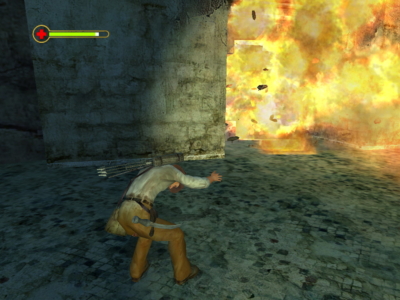
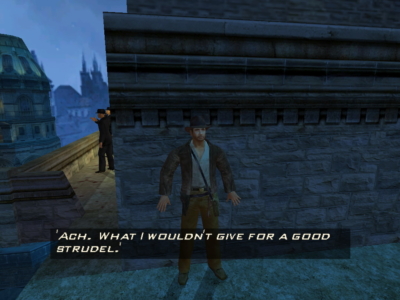
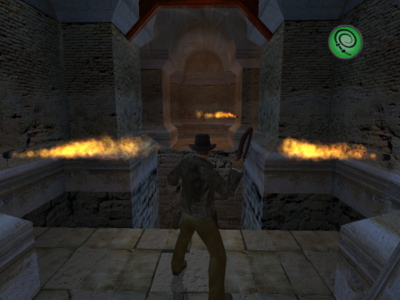
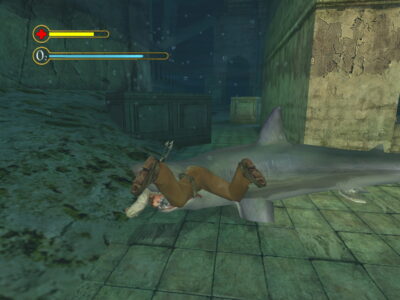

 Posts
Posts